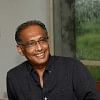
Kazi Khaleed Ashraf
Kazi Khaleed Ashraf is an architect and urbanist, and director-general of Bengal Institute for Architecture, Landscapes and Settlements.
Kazi Khaleed Ashraf is an architect and urbanist, and director-general of Bengal Institute for Architecture, Landscapes and Settlements.
Since the 1960s, Prof Abdur Razzaq wielded considerable influence on the academic and literati circle of his time,.
Claiming that Dhaka is an island is an earnest call for an ecological and nature-oriented restoration of the city, and to experience.
Before the construction of the beribadh in the early 1990s, the nameless water body was part of the overflow zone of the Turag River.
It is no wonder that a vast population of Dhaka are generally disgruntled with where they are.
The city is perhaps the greatest innovation carried out by humans. Although nature has been used as an analogy in conceiving the fabric of the city, there is no such thing as the “city” in nature.
Described as the doyen of Bangladesh’s architecture, Muzharul Islam introduced modernism in the country as well as the highest ideals of the craft.
The city, the one that we want to arrive at, remains illusory
Before the amber of the last one turn to ashes and forgotten memories, a new flame leaps up in another neighbourhood of the city, revealing, once again, cracks in the façade of our tilottoma.
A city is not mere buildings, streets and spaces; it is a theatre of social actions. And it is in that theatre, according to the American urbanist Lewis Mumford, that “man's more purposive activities…work out, through conflicting cooperative
Mud is the bane of the Bengali middle-class. Yet, mud is all over the place. Mud—that gooey, gluey, brown muck—lies waiting in the dry dust and with a little sprinkling of water rises up in rebellion, and grabs the pumps, heels and sandals of the middle-class and makes them skid off balance.
I have known for a long time that one does not go anywhere. It is the cities of the countries that come or do not come to you. Cities are fateful letters. They only arrive lost. They only arrive posthumously.”
Despite the usual gloomy narratives, there are opportunities to transform Dhaka into a modern but ecologically attuned metropolis. The transformation can be carried out with our own resources, and our own imagination.
Public spaces constitute the life-stream of a city, and these are in short supply in Dhaka.
If after thousands of years of human civilisation, we crawl on our roads in our vehicles at 7km per hour and die untimely deaths just by walking, there is something wrong with the picture.
All cities change, and better cities—those that are not at the lowest rung of “most liveable cities”—change through careful planning and crafting of its assets. Dhaka is changing through radical norms, in a fury of demolition and building.
Tomorrow's Bangladesh is already here. Achievements and progress in all fields—from manufacturing to cricket, and from architectural excellence to social indicators—open up new prospects and promises for Bangladesh. PricewaterhouseCoopers, in its global economic projection for 2050, estimates that Bangladesh can potentially become the world's 28th largest economy by 2030, surpassing countries like Australia, Spain, South Africa, and Malaysia in economic growth.
Dhaka is a paradox. The more we build assuming we are “developing,” the more we dig ourselves into an urban mess: Transportation is a chaos. Travelling is a nightmare. Khals vanish, and roads turn to khals. Public space is non-existent. Housing is in disarray.